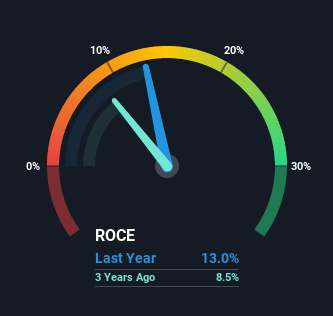If we want to find a stock that could multiply over the long term, what are the underlying trends we should look for? Amongst other things, we'll want to see two things; firstly, a growing return on capital employed (ROCE) and secondly, an expansion in the company's amount of capital employed. If you see this, it typically means it's a company with a great business model and plenty of profitable reinvestment opportunities. So on that note, Mercor (WSE:MCR) looks quite promising in regards to its trends of return on capital.
What is Return On Capital Employed (ROCE)?
For those that aren't sure what ROCE is, it measures the amount of pre-tax profits a company can generate from the capital employed in its business. To calculate this metric for Mercor, this is the formula:
Return on Capital Employed = Earnings Before Interest and Tax (EBIT) ÷ (Total Assets - Current Liabilities)
0.13 = zł36m ÷ (zł398m - zł121m) (Based on the trailing twelve months to September 2021).
So, Mercor has an ROCE of 13%. By itself that's a normal return on capital and it's in line with the industry's average returns of 13%.
Check out our latest analysis for Mercor

While the past is not representative of the future, it can be helpful to know how a company has performed historically, which is why we have this chart above. If you'd like to look at how Mercor has performed in the past in other metrics, you can view this free graph of past earnings, revenue and cash flow.
So How Is Mercor's ROCE Trending?
Mercor is displaying some positive trends. The data shows that returns on capital have increased substantially over the last five years to 13%. The company is effectively making more money per dollar of capital used, and it's worth noting that the amount of capital has increased too, by 72%. This can indicate that there's plenty of opportunities to invest capital internally and at ever higher rates, a combination that's common among multi-baggers.
On a related note, the company's ratio of current liabilities to total assets has decreased to 30%, which basically reduces it's funding from the likes of short-term creditors or suppliers. This tells us that Mercor has grown its returns without a reliance on increasing their current liabilities, which we're very happy with.
The Bottom Line On Mercor's ROCE
All in all, it's terrific to see that Mercor is reaping the rewards from prior investments and is growing its capital base. Investors may not be impressed by the favorable underlying trends yet because over the last five years the stock has only returned 3.4% to shareholders. So with that in mind, we think the stock deserves further research.
If you want to continue researching Mercor, you might be interested to know about the 3 warning signs that our analysis has discovered.
While Mercor isn't earning the highest return, check out this free list of companies that are earning high returns on equity with solid balance sheets.
New: Manage All Your Stock Portfolios in One Place
We've created the ultimate portfolio companion for stock investors, and it's free.
• Connect an unlimited number of Portfolios and see your total in one currency
• Be alerted to new Warning Signs or Risks via email or mobile
• Track the Fair Value of your stocks
Have feedback on this article? Concerned about the content? Get in touch with us directly. Alternatively, email editorial-team (at) simplywallst.com.
This article by Simply Wall St is general in nature. We provide commentary based on historical data and analyst forecasts only using an unbiased methodology and our articles are not intended to be financial advice. It does not constitute a recommendation to buy or sell any stock, and does not take account of your objectives, or your financial situation. We aim to bring you long-term focused analysis driven by fundamental data. Note that our analysis may not factor in the latest price-sensitive company announcements or qualitative material. Simply Wall St has no position in any stocks mentioned.
About WSE:MCR
Mercor
Designs, manufactures, sells, installs, and services passive fire protection systems.
Adequate balance sheet second-rate dividend payer.
Market Insights
Community Narratives


